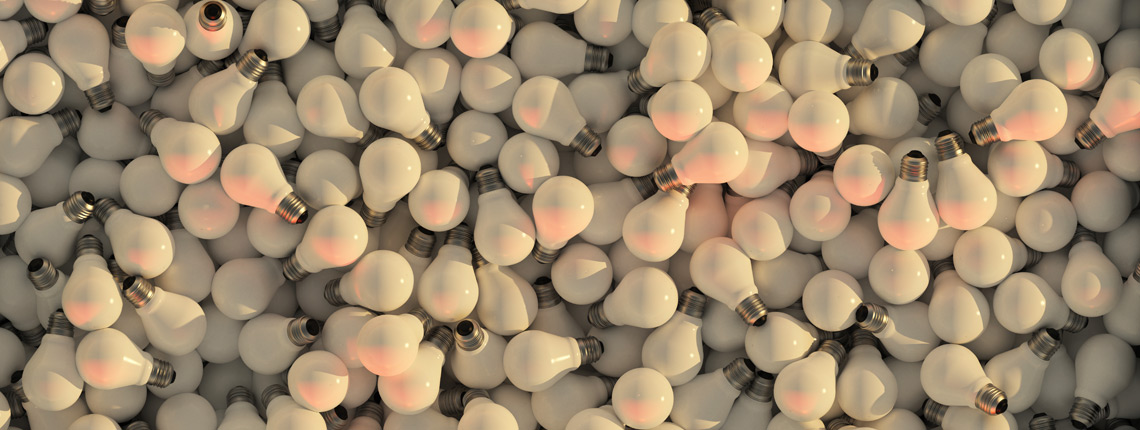

The light bulb ban. Or ‘The European legislation for phase-out of incandescent lamps’ as we lighting professionals affectionately like to refer to it, is well under way, but what is it, how will it affect you, and why should you care?
At the start of this month (September 2012) effectively all incandescent lamps will be ‘banned’ for general use.
For those that don’t know, an Incandescent lamp or general lighting service (GLS) light bulb, are the much loved filament bulbs installed in the majority of homes.
It started on September 1 2009, when a regulation from the European Union came into effect, which prevents the manufacture of certain types of inefficient lamps. The legislation is being implemented in phases, to give everyone time to adjust. These phases are:
All non-clear (so frosted and opal) incandescent lamps. And clear incandescent lamps greater or equal to 100W
Clear incandescent lamps with wattage 75W or higher. Plus clear halogen lamps 60W or higher with class ‘D’ energy rating or lower.
Clear incandescent lamps with wattage 60W or higher. Plus clear halogen lamps 40W or higher with class ‘D’ energy rating or lower.
Clear incandescent lamps with wattage 25W or higher. Plus clear halogen lamps 25W or higher with class ‘D’ energy rating or lower.
Increase in other performances
So why is this happening? The legislation is being implemented to increase the use of efficient lamps by the public and industry, lowering carbon emissions and energy consumption. Incandescent has served us well for around 120 years. However, let’s not forget that this technology is over 100 years old and we now have many viable, more efficient sources on the market. There are a number of estimates, ranging from 24-39million tons of annual carbon dioxide emissions that will be eliminated with the implementation of this EU regulation. That’s equivalent to around 156 million barrels of oil, 1000 million trees or 2500 Wembley stadiums. Let’s not forget that around 14% of all electricity usage in Europe is used on lighting, and forcing consumers, through legislation, to adopt new technology will help governments meet the targets they signed up to under the Kyoto agreement.
This is not another burden forced upon us by the powers of Europe. Brazil and Venezuela started to phase out incandescent in 2005 . Switzerland, Australia, Argentina, Russia, Canada, USA, Malaysia and China have all started, or due to start a phase out – this truly is a global initiative.
To clarify, it not illegal to use, buy, or even sell the ‘banned’ light bulbs. It’s just these products are no longer being made by European lamp manufactures, and as they’re not allowed to be imported into the Euro zone, they will slowly start disappearing and the remaining few will soar in price.
Fortunately there are many alternatives available, compact fluorescent’s (CFL or energy savers), and LED’s are taking over, producing the same output as conventional GLS lamps but using a fraction of the power. A lot of people we come across question the colour and quality of light from these alternatives. However, there really are some fantastic and efficient substitutes out there. For many years cheap, poor quality CFL’s have flooded the market and given compact fluorescents a bad name. Today LED’s are far superior and better than they were several months ago, yet alone compared to the ones from last year. LED technology has evolved rapidly and providing the low cost, poor quality products are avoided, there’s no reason why the quality of efficient lighting has to be compromised.
Currently there are incandescent sources that are not included in the scope of the EU regulation. True colour lamps, directional (reflector) lamps, lamps with lumens less than 60 or higher than 12,000 and rough service lamps are available. In fact several lamp suppliers are providing conventional GLS bulbs under the pretext of rough service lamps, although this loop hole cannot be exploited for long.
At the lighting design studio, ultimately we believe the phase out of this 100 year old technology is a good thing. With a finite supply of natural resources and the increasing cost of electricity, reducing our energy consumption is not bad thing and switching will also repeatedly save money on your utility bill. Many of the alternatives are a little more expensive to purchase, but by and large, these pay for themselves within a short period of time. Feel free to contact the lighting design studio for detailed payback calculations and further advice on the best quality light sources to use. Used intelligently, efficient lighting doesn’t have to be compromise on quality.